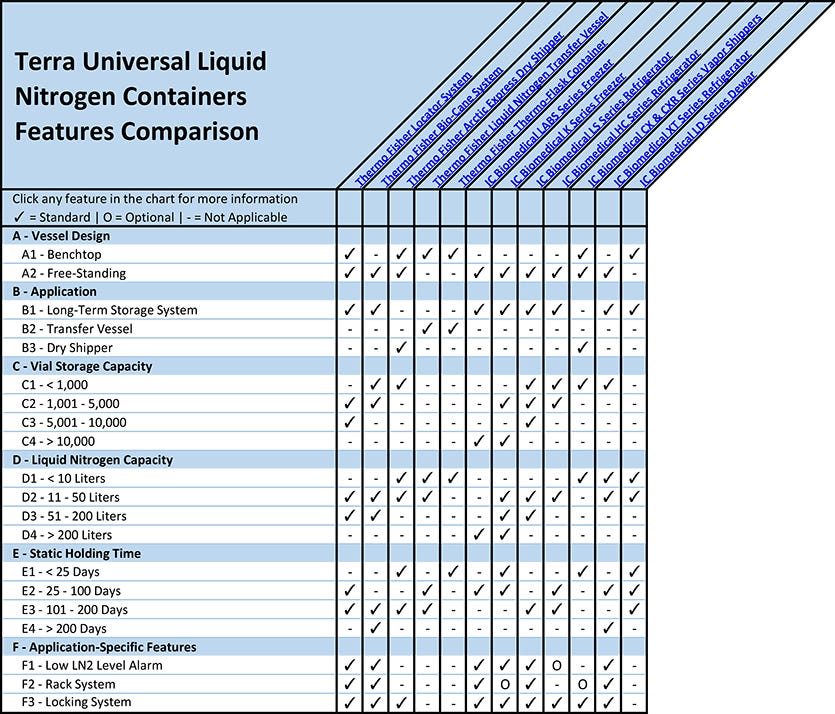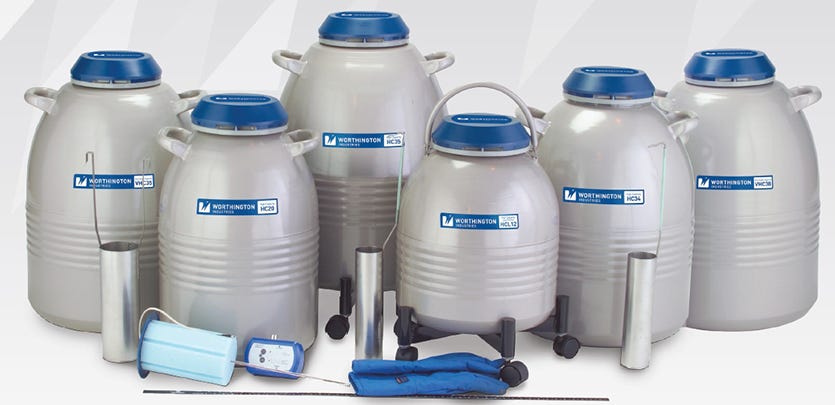
Liquid nitrogen vessels are designed to support long-term storage of samples at cryogenic temperatures (-196°C to -210°C). The process of cryo-preservation is widely used in clinical diagnostics, immunotherapy development, food and beverage, and semiconductor storage. Samples prepared with cryo-protectants, such as DMSO, can remain viable for up to a decade when stored in liquid nitrogen.
Liquid Nitrogen Tanks and Styles
Liquid nitrogen tanks are manufactured in two primary styles:
- Pressurized cryogenic freezers for long-term liquid- or vapor-phase LN2 storage
- Non-pressurized, benchtop dewars for liquid nitrogen transfer.
Cryogenic freezers are designed as sample retrieval systems (with locking lids, low liquid level indicators, and audible alarms) or IATA-approved shipping vessels for global sample transport.
A - Liquid Nitrogen Vessel Design
(back to chart)
A1 - Benchtop
Benchtop liquid nitrogen containers are designed for point-of-use, short-term sample storage or transfer of LN2 into a shipping vessel or cold trap. Benchtop dewars store fewer than 10 liters of liquid nitrogen and do not include sample storage racks. Certain benchtop vessels include carrying handles for easy transport and vented lids to prevent over-pressurization.
A2 - Free-Standing Liquid Nitrogen Systems
Free-standing liquid nitrogen systems are optimal for long-term sample storage within a cryogenic environment. Select models include cryo-box racks for easy sample identification, low liquid level alarms to maintain cryo-preservation conditions, and locking lids for high-security areas. High-capacity, free-standing systems are designed to store more than 10,000 samples and over 300 liters of liquid nitrogen.
B - Application
(back to chart)
B1 - Long-Term Storage System
Nitrogen Storage Systems for Cryogenics
Long-term sample storage and retrieval systems include racks compatible with 81-cell or 100-cell cryogenic boxes to maximize sample capacity. Certain systems include locking lids for added sample protection and wheeled bases for easy transport. Low liquid level alarms alert users when an LN2 refill is required.
Shop LN2 Tanks and LN2 Containers
Low-capacity systems store less than 200 samples while high-capacity systems store more than 10,000 samples. Static holding times vary from less than 20 days to more than 300 days.
Shop N2 Storage Systems for Cryogenics
B2 - Liquid Nitrogen Transfer Vessel
Benchtop transfer vessels are designed to transport liquid nitrogen from a holding tank to a sample storage system or shipping vessel. Select transfer vessels are compatible with pressurized liquid withdrawal devices to prevent LN2 spillage and evaporation.
Liquid Nitrogen Transfer Vessels by Thermo Fisher Scientific
B3 - Liquid Nitrogen Dry Shipper
Dry shipping vessels maintain cryogenic conditions for global sample transport. Select units include secure data-logging systems for 21CFR Part 11 compliance.
C - Liquid Nitrogen Vial Storage Capacity
(back to chart)
Cryogenic storage systems utilize racks compatible with 81-cell or 100-cell cryo-boxes to maximize sample capacity. Samples are generally stored in 1.5 ml or 2 ml cryo-tubes or twist-cap vials. Low-capacity systems are designed to store fewer than 1,000 samples, while high-capacity containers store more than 10,000 samples.
D - Liquid Nitrogen Capacity
(back to chart)
For laboratories without a liquid nitrogen delivery service, cryogenic vessels are earmarked as long-term LN2 holding tanks to supply sample storage systems and cold traps used throughout the lab.
For labs purchasing an LN2 holding tank, a critical specification is liquid nitrogen storage capacity. Low-throughput systems store fewer than 50 liters of liquid nitrogen, while high-throughput tanks store more than 200 liters.
E - Liquid Nitrogen Static Holding Time
(back to chart)
Static holding time is the length of time listed in days, during which the cryogenic tank retains the supplied volume of liquid nitrogen. This metric, however, presumes that the container is not accessed during the stated period of time. LN2 evaporation will occur each time the cryogenic tank is opened.
Narrow-neck pressurized containers are designed to reduce LN2 evaporation rates, whereas wide-neck dewars allow for greater liquid nitrogen evaporation each time the container is opened.
F - Liquid Nitrogen Application-Specific Features
(back to chart)
F1 - Low LN2 Level Alarm for Cryogenic Tanks
Certain cryogenic tanks, such as Thermo Fisher Locator Storage Systems, include ultrasonic level monitors with continuous digital LED readouts and audible/visual alarms when liquid nitrogen levels fall below set-point.
Shop Cryogenic Tanks with Alarms
F2 - Liquid Nitrogen Rack System
Sample storage systems accommodate stainless steel and aluminum racks for easy retrieval of cryo-storage boxes. Racks are compatible with 81-cell or 100 cell boxes for 2 ml cryo-tubes or 1.5 ml twist-cap vials. Certain models offer racks compatible with 5 ml high-capacity vials.
F3 - Liquid Nitrogen Locking System
For high-security sample storage, certain LN2 containers include locking lids equipped with optional padlocks, keypads or fingerprint scanners.
Shop Liquid Nitrogen Tanks and Storage Products
Where Can I Buy Liquid Nitrogen Vessels and Storage Freezers?
Laboratory-Equipment.com is a specialty division of Terra Universal. For nearly 40 years, Terra Universal has served semiconductor, aerospace, life science, pharmaceutical, biotechnology, and medical device markets. Customers appreciate a worldwide network of reps, factory-direct support, and ready-to-ship items available from Terra's manufacturing and warehouse facilities in Fullerton, California.
Shop online to compare pricing, features, and selection for a wide variety of liquid nitrogen storage vessels, dewars, dry shippers, and freezers.



